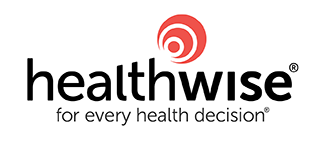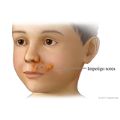Check Your Symptoms
Overview
Blisters are fluid-filled bumps that look like bubbles on the skin. You may get a blister on your foot when you wear shoes that rub against your skin. Or you may get one on your hand when you work in the garden without wearing gloves. Home treatment is often all that's needed for this type of blister.
Other types of injuries to the skin can cause a blister. They include:
- Burns from exposure to heat, electricity, chemicals, radiation from the sun, or friction.
- Cold injuries from being exposed to cold or freezing temperatures.
- Some spider bites. A blister may form at the site of the bite.
- Pinching the skin forcefully, like when a finger gets caught in a drawer. A blood blister may form if tiny blood vessels are damaged.
Infection can cause either a single blister or clusters of blisters.
- Infections caused by viruses include:
- Chickenpox (varicella). This starts as red bumps that turn into blisters and then scab over.
- Shingles. These blisters look like chickenpox. But they usually form in a band on one side of the body.
- Hand-foot-and-mouth disease. This causes a rash of small sores or blisters that usually appear on the hands and feet and in the mouth.
- Cold sores. These clusters of small blisters on the lip and outer edge of the mouth are caused by the herpes simplex virus. A genital herpes infection may cause cold sore-type blisters in the genital area.
- Infections caused by bacteria include:
- Impetigo. This usually causes blisters on the face that burst and become crusty.
- Infected hair follicles (folliculitis). This condition causes red, tender areas that turn into blisters at or near the base of strands of hair.
Other causes of blisters include:
- Scabies. A scabies infection may cause tiny, itchy blisters that often form in a thin line or curved track.
- Bedbug bites. They can cause tiny, itchy blisters anywhere on the body.
- Contact dermatitis. This occurs when skin touches something in the environment that causes an allergic reaction.
- Autoimmune diseases. They can cause symptoms like blisters and rashes.
Blisters may also be caused by medicines.
- Sometimes they may be caused by a prescription or an over-the-counter medicine or ointment, such as antibiotics or pain medicine. The blisters most often occur with red, itchy skin. If the blisters aren't severe and you don't have other symptoms, stopping the use of the medicine or ointment may be all that's needed.
- Blisters may also occur as a symptom of a very serious reaction to a medicine. One example is Stevens-Johnson syndrome. Blisters that occur with other signs of illness, such as a fever or chills, may also mean a more serious problem.
Check Your Symptoms
The medical assessment of symptoms is based on the body parts you have.
- If you are transgender or non-binary, choose the sex that matches the body parts (such as ovaries, testes, prostate, breasts, penis, or vagina) you now have in the area where you are having symptoms.
- If your symptoms aren’t related to those organs, you can choose the gender you identify with.
- If you have some organs of both sexes, you may need to go through this triage tool twice (once as "male" and once as "female"). This will make sure that the tool asks the right questions for you.
Many things can affect how your body responds to a symptom and what kind of care you may need. These include:
- Your age. Babies and older adults tend to get sicker quicker.
- Your overall health. If you have a condition such as diabetes, HIV, cancer, or heart disease, you may need to pay closer attention to certain symptoms and seek care sooner.
- Medicines you take. Certain medicines, such as blood thinners (anticoagulants), medicines that suppress the immune system like steroids or chemotherapy, or natural health products can cause symptoms or make them worse.
- Recent health events, such as surgery or injury. These kinds of events can cause symptoms afterwards or make them more serious.
- Your health habits and lifestyle, such as eating and exercise habits, smoking, alcohol or drug use, sexual history, and travel.
Try Home Treatment
You have answered all the questions. Based on your answers, you may be able to take care of this problem at home.
- Try home treatment to relieve the symptoms.
- Call your doctor if symptoms get worse or you have any concerns (for example, if symptoms are not getting better as you would expect). You may need care sooner.
Symptoms of infection may include:
- Increased pain, swelling, warmth, or redness in or around the area.
- Red streaks leading from the area.
- Pus draining from the area.
- A fever.
Symptoms of serious illness may include:
- A severe headache.
- A stiff neck.
- Mental changes, such as feeling confused or much less alert.
- Extreme fatigue (to the point where it's hard for you to function).
- Shaking chills.
Symptoms of serious illness in a baby may include the following:
- The baby is limp and floppy like a rag doll.
- The baby doesn't respond at all to being held, touched, or talked to.
- The baby is hard to wake up.
Usually found in dirt and soil, tetanus bacteria typically enter the body through a wound. Wounds may include a bite, a cut, a puncture, a burn, a scrape, insect bites, or any injury that may cause broken skin.
You may need a tetanus shot depending on how dirty the wound is and how long it has been since your last shot.
- For a deep or dirty wound that has things like dirt, saliva, or feces in it, you may need a shot if:
- You haven't had a tetanus shot in the past 5 years.
- You don't know when your last shot was.
- You have not received 3 doses of the tetanus vaccine series.
- For a clean wound, you may need a shot if:
- You have not had a tetanus shot in the past 10 years.
- You don't know when your last shot was.
- You have not received 3 doses of the tetanus vaccine series.
Pain in adults and older children
- Severe pain (8 to 10): The pain is so bad that you can't stand it for more than a few hours, can't sleep, and can't do anything else except focus on the pain.
- Moderate pain (5 to 7): The pain is bad enough to disrupt your normal activities and your sleep, but you can tolerate it for hours or days. Moderate can also mean pain that comes and goes even if it's severe when it's there.
- Mild pain (1 to 4): You notice the pain, but it is not bad enough to disrupt your sleep or activities.
Pain in children under 3 years
It can be hard to tell how much pain a baby or toddler is in.
- Severe pain (8 to 10): The pain is so bad that the baby cannot sleep, cannot get comfortable, and cries constantly no matter what you do. The baby may kick, make fists, or grimace.
- Moderate pain (5 to 7): The baby is very fussy, clings to you a lot, and may have trouble sleeping but responds when you try to comfort him or her.
- Mild pain (1 to 4): The baby is a little fussy and clings to you a little but responds when you try to comfort him or her.
Many prescription and non-prescription medicines, including some that you put directly on the skin, may cause blisters. A few examples are:
- Antibiotics.
- Non-steroidal anti-inflammatory drugs (NSAIDs), such as ibuprofen (for example, Advil or Motrin).
- Medicines you put on your skin (topical medicines), such as Neosporin or benzocaine (for example, Anbesol, Hurricaine, or Orajel), and ethylenediamine, which is used in some topical medicines.
- Seizure medicines.
Certain health conditions and medicines weaken the immune system's ability to fight off infection and illness. Some examples in adults are:
- Diseases such as diabetes, cancer, heart disease, and HIV/AIDS.
- Long-term alcohol and drug problems.
- Steroid medicines, which may be used to treat a variety of conditions.
- Chemotherapy and radiation therapy for cancer.
- Other medicines used to treat autoimmune disease.
- Medicines taken after organ transplant.
- Not having a spleen.
Seek Care Today
Based on your answers, you may need care soon. The problem probably will not get better without medical care.
- Call your doctor today to discuss the symptoms and arrange for care.
- If you cannot reach your doctor or you don't have one, seek care today.
- If it is evening, watch the symptoms and seek care in the morning.
- If the symptoms get worse, seek care sooner.
Call 9-1-1 Now
Based on your answers, you need emergency care.
Call 9-1-1 or other emergency services now.
Sometimes people don't want to call 9-1-1. They may think that their symptoms aren't serious or that they can just get someone else to drive them. Or they might be concerned about the cost. But based on your answers, the safest and quickest way for you to get the care you need is to call 9-1-1 for medical transport to the hospital.
Seek Care Now
Based on your answers, you may need care right away. The problem is likely to get worse without medical care.
- Call your doctor now to discuss the symptoms and arrange for care.
- If you cannot reach your doctor or you don't have one, seek care in the next hour.
- You do not need to call an ambulance unless:
- You cannot travel safely either by driving yourself or by having someone else drive you.
- You are in an area where heavy traffic or other problems may slow you down.
Make an Appointment
Based on your answers, the problem may not improve without medical care.
- Make an appointment to see your doctor in the next 1 to 2 weeks.
- If appropriate, try home treatment while you are waiting for the appointment.
- If symptoms get worse or you have any concerns, call your doctor. You may need care sooner.
Self-Care
Most blisters heal on their own. Home treatment may help decrease pain, prevent infection, and help heal large or broken blisters.
- Bandage small blisters.
A small, unbroken blister about the size of a pea, even a blood blister, will usually heal on its own. Use a loose bandage to protect it. Avoid the activity that caused the blister.
If a small blister is on a weight-bearing area like the bottom of the foot, protect it with a doughnut-shaped moleskin pad. Leave the area over the blister open.
- Don't drain a blister unless you really need to.
It's best not to drain a blister at home. But if a blister is large and very painful, or it's in a spot where it can't avoid getting popped, you may need to drain it. If you do decide to drain your blister, be sure to follow these steps:
- Wash your hands and gently wash the area around the blister.
- Wipe a needle with rubbing alcohol.
- Gently puncture the edge of the blister.
- Press the fluid in the blister toward the hole so it can drain out.
Don't drain a blister of any size if:
- You have a condition such as diabetes, HIV, cancer, or heart disease. Draining a blister increases your risk of infection.
- You think your blister is from a contagious disease, such as chickenpox. If you drain that type of blister, the virus can spread to another person.
- Clean and cover a torn or drained blister.
If a blister has torn open, or after you have drained a blister:
- Carefully smooth the flap over the tender skin and keep the area as clean as possible. Don't remove the flap unless there is pus or the area looks infected.
- If the flap of skin over a blister is very dirty or has torn, gently wash the area. If possible, put the flap of skin back in place. Don't use hydrogen peroxide or alcohol on the blister. They can slow healing.
- You may cover the blister with a thin layer of petroleum jelly, such as Vaseline, and a non-stick bandage.
- Apply more petroleum jelly and replace the bandage as needed.
- Watch for signs of infection.
Watch for a skin infection while your blister heals. Signs of infection include:
- Increased pain, swelling, redness, or warmth around the blister.
- Red streaks leading from the blister.
- Pus draining from the blister.
- A fever.
When to call for help during self-care
Call a doctor if any of the following occur during self-care at home:
- New or worse pain.
- New signs of an infection, such as redness, warmth, swelling, or pus.
- New crusty blister that drains honey-coloured fluid.
- New blisters in your mouth, on your nose, near your eyes, or in your genital area.
- New signs of a more serious illness, such as shaking chills, fever, belly pain, vomiting or diarrhea, muscle or joint aches, or a headache.
- Symptoms occur more often or are more severe.
Learn more
Preparing For Your Appointment
You can help your doctor diagnose and treat your condition by being prepared for your appointment.
Credits
Current as of: March 22, 2023
Author: Healthwise Staff
Medical Review:
William H. Blahd Jr. MD, FACEP - Emergency Medicine
Adam Husney MD - Family Medicine
Kathleen Romito MD - Family Medicine
Current as of: March 22, 2023
Author: Healthwise Staff
Medical Review:William H. Blahd Jr. MD, FACEP - Emergency Medicine & Adam Husney MD - Family Medicine & Kathleen Romito MD - Family Medicine











